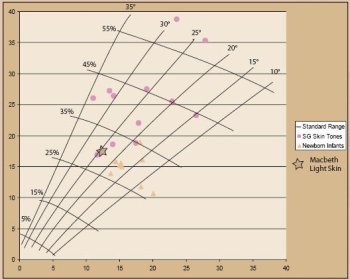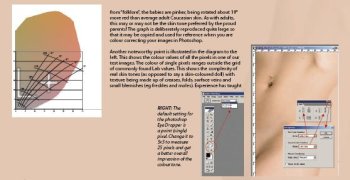articles/Printing/accurateskintone-page2
The Accurate Reproduction Of Skin Tones - part 2 of 1 2 3 4 5 6 7 8
by Mike McNamee Published 01/06/2005

The matt skin colour appearance is influenced by the light filtering capabilities of three main colouring agents: melanin in epidermis, carotene in dermis and subcutaneous fat, and blood capillaries across the dermis. Melanin is a brown pigment and carotene gives an orange tint. Haemoglobin (an element of blood) can produce two different tints: if the haemoglobin is oxygenated (oxyhemoglobin), the tint is reddish or pinkish apart from when it is deoxygenated (reduced haemoglobin) then the tint is bluish. Like most natural objects, the skin has variability, which in this case is mainly due to amount, density, and distribution of melanin. Under the surface there are colourant particles which interact with light, producing scattering and colouration. The variation within a person can be quite marked, freckles being the classic example. There are also differences around the body. Production of melanin darkens the skin of the person to protect them against the harmful effects of the sun's uv rays. For this reason the soles of the feet and palms of the hand contain less melanin and are pinker. The quantities of melanin vary with ethnicity and roughly correspond to the following variations:
Light Skinned Caucasians 1-3%
Well-Tanned Caucasians and Mediterranean 11-16%
Darkly Pigmented Africans 18-43%

L The lightness usually expressed as a percentage
a the redness to greenness of a colour
b the yellowness to blueness of a colour
There are huge advantages to separating the lightness values of a colour from its hue and saturation, which is what you can do by using Lab values. Ignoring the variations in different parts of the body, the values of a and b remain more constant around an image which may be lit is cross lighting. In this case the dark side of a face may have different L values but near identical a and b values to the lighter side.
There is another advantage to Lab. The concentration of melanin governs the "tan" of a skin colour by changes to the a value and the L value. The blood flow and concentration of blood vessels close to the surface effect the Lab b value. However just to confuse matters there are several types of melanin; a red and yellow sort. Red melanin is higher in Irish, Danish and Dutch populations which also colour red hair red! Within these variations, the presence of carotene (which is orange) influences the tone where it is stored in the subcutaneous fats and this underlying variability gives skin its variable texture and tone. Carotene concentration can be affected by diet - you may recall the little girl who turned orange after drinking way too much of a proprietary orange drink.
The problem which faces us as photographers is that we have to distil all this colour variability and conjure up a pleasing picture. To do these we need practical guidelines of how colour should be adjusted to achieve a particular "look".
Please Note:
There is more than one page for this Article.
You are currently on page 2
- The Accurate Reproduction Of Skin Tones page 1
- The Accurate Reproduction Of Skin Tones page 2
- The Accurate Reproduction Of Skin Tones page 3
- The Accurate Reproduction Of Skin Tones page 4
- The Accurate Reproduction Of Skin Tones page 5
- The Accurate Reproduction Of Skin Tones page 6
- The Accurate Reproduction Of Skin Tones page 7
- The Accurate Reproduction Of Skin Tones page 8
1st Published 01/06/2005
last update 09/12/2022 14:50:45
More Printing Articles
There are 17 days to get ready for The Society of Photographers Convention and Trade Show at The Novotel London West, Hammersmith ...
which starts on Wednesday 14th January 2026





